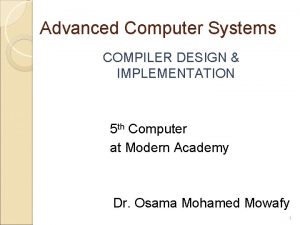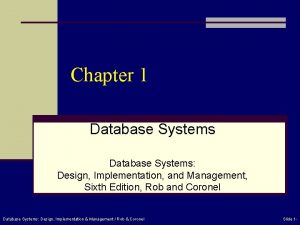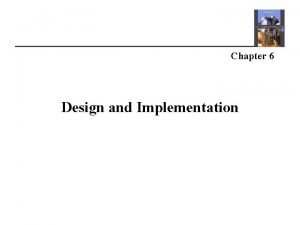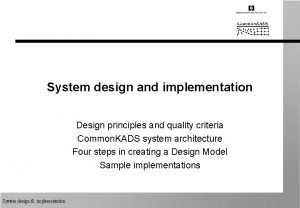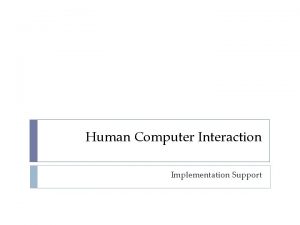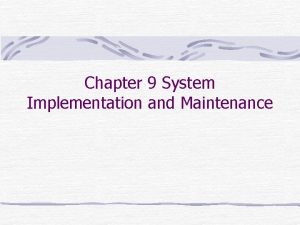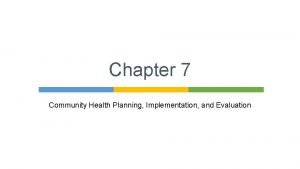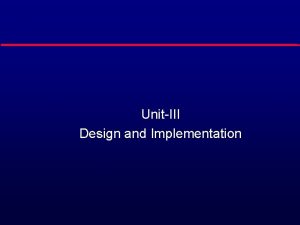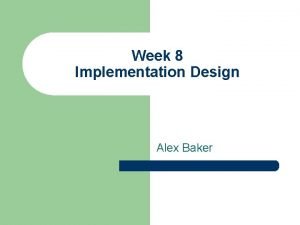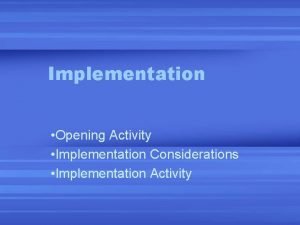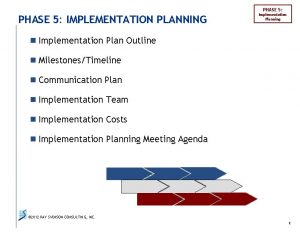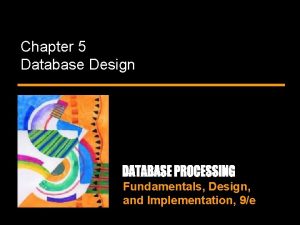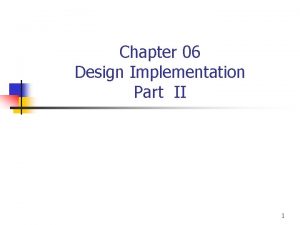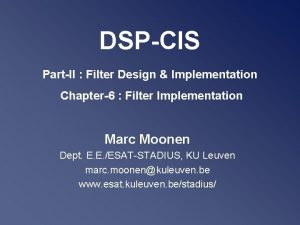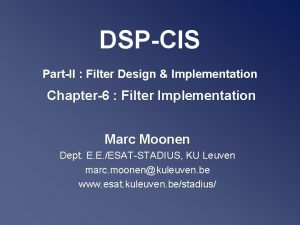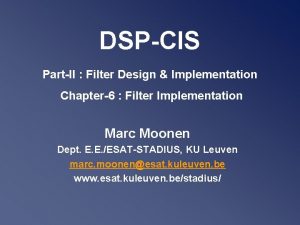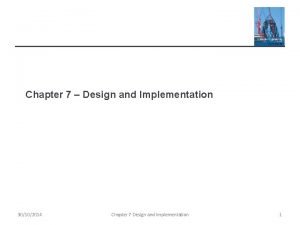Chapter 6 Design and Implementation Design And Implementation
























- Slides: 24

Chapter 6 Design and Implementation

Design And Implementation Software design and implementation is the stage in the software engineering process at which an executable software system is developed. Software design and implementation activities are invariably interleaved. Software design is a creative activity in which you identify software components and their relationships, based on a customer’s requirements. Implementation is the process of realizing the design as a program. Design and implementation Chapter 6 2

6. 1 An Object-oriented Design Process Structured object-oriented design processes involve developing a number of different system models. They require a lot of effort for development and maintenance of these models and, for small systems, this may not be cost-effective. However, for large systems developed by different groups design models are an important communication mechanism. Design and implementation Chapter 6 3

Process Stages There a variety of different object-oriented design processes that depend on the organization using the process. Common activities in these processes include: § § § Define the context and modes of use of the system; Design the system architecture; Identify the principal system objects; Develop design models; Specify object interfaces. Design and implementation Chapter 6 4

6. 1. 1 System Context And Interactions • Understanding the relationships between the software that is being designed and its external environment is essential for deciding how to provide the required system functionality and how to structure the system to communicate with its environment. • Understanding of the context also lets you establish the boundaries of the system. Setting the system boundaries helps you decide what features are implemented in the system being designed and what features are in other associated systems. Design and implementation Chapter 6 5

Context and Interaction Models • A system context model is a structural model that demonstrates the other systems in the environment of the system being developed. • An interaction model is a dynamic model that shows how the system interacts with its environment as it is used. Design and implementation Chapter 6 6

System Context For The Weather Station Figure 6. 1 Design and implementation Chapter 6 7

Weather Station Use Cases Figure 6. 2 Design and implementation Chapter 6 8

Use Case Description—Report Weather System Weather station Use case Report weather Actors Weather information system, Weather station Description The weather station sends a summary of the weather data that has been collected from the instruments in the collection period to the weather information system. The data sent are the maximum, minimum, and average ground air temperatures; the maximum, minimum, and average air pressures; the maximum, minimum, and average wind speeds; the total rainfall; and the wind direction as sampled at five-minute intervals. Stimulus The weather information system establishes a satellite communication link with the weather station and requests transmission of the data. Response The summarized data is sent to the weather information system. Comments Weather stations are usually asked to report once per hour but this frequency may differ from one station to another and may be modified in the future. Design and implementation Chapter 6 Figure 6. 3 9

6. 2 Implementation Issues Software engineering includes all of the activities involved in software development from the initial requirements of the system through to maintenance and management of the deployed system. A critical stage of this process is, of course, system implementation, where you create an executable version of the software. Implementation may involve developing programs in high- or lowlevel programming languages or tailoring and adapting generic, offthe-shelf systems to meet the specific requirements of an organization. Some aspects of implementation that are particularly important to software engineering that are often not covered in programming texts. These are: Design and implementation Chapter 6 10

Implementation Issues Reuse: Most modern software is constructed by reusing existing components or systems. When you are developing software, you should make as much use as possible of existing code. Configuration management: During the development process, you have to keep track of the many different versions of each software component in a configuration management system. Host-target development: Production software does not usually execute on the same computer as the software development environment. Rather, you develop it on one computer (the host system) and execute it on a separate computer (the target system). Design and implementation Chapter 6 11

Reuse From the 1960 s to the 1990 s, most new software was developed from scratch, by writing all code in a high-level programming language. § The only significant reuse or software was the reuse of functions and objects in programming language libraries. § Costs and schedule pressure mean that this approach became increasingly unviable, especially for commercial and Internet-based systems. § An approach to development based around the reuse of existing software emerged and is now generally used for business and scientific software. Design and implementation Chapter 6 12

Reuse Levels The abstraction level At this level, you don’t reuse software directly but use knowledge of successful abstractions in the design of your software. The object level At this level, you directly reuse objects from a library rather than writing the code yourself. The component level Components are collections of objects and object classes that you reuse in application systems. The system level At this level, you reuse entire application systems. Design and implementation Chapter 6 13

Reuse Costs 1. The costs of the time spent in looking for software to reuse and assessing whether or not it meets your needs. 2. Where applicable, the costs of buying the reusable software. For large off-the-shelf systems, these costs can be very high. 3. The costs of adapting and configuring the reusable software components or systems to reflect the requirements of the system that you are developing. 4. The costs of integrating reusable software elements with each other (if you are using software from different sources) and with the new code that you have developed. Design and implementation Chapter 6 14

Configuration Management • Configuration management is the name given to the general process of managing a changing software system. • The aim of configuration management is to support the system integration process so that all developers can access the project code and documents in a controlled way, find out what changes have been made, and compile and link components to create a system. Design and implementation Chapter 6 15

Configuration Management Activities • Version management, where support is provided to keep track of the different versions of software components. Version management systems include facilities to coordinate development by several programmers. • System integration, where support is provided to help developers define what versions of components are used to create each version of a system. This description is then used to build a system automatically by compiling and linking the required components. • Problem tracking, where support is provided to allow users to report bugs and other problems, and to allow all developers to see who is working on these problems and when they are fixed. Design and implementation Chapter 6 16

Host-Target Development Most software is developed on one computer (the host), but runs on a separate machine (the target). More generally, we can talk about a development platform and an execution platform. § A platform is more than just hardware. § It includes the installed operating system plus other supporting software such as a database management system or, for development platforms, an interactive development environment. Development platform usually has different installed software than execution platform; these platforms may have different architectures. Design and implementation Chapter 6 17

Open Source Development Open source development is an approach to software development in which the source code of a software system is published and volunteers are invited to participate in the development process Its roots are in the Free Software Foundation (www. fsf. org), which advocates that source code should not be proprietary but rather should always be available for users to examine and modify as they wish. Open source software extended this idea by using the Internet to recruit a much larger population of volunteer developers. Many of them are also users of the code. Design and implementation Chapter 6 18

Open Source Systems § The best-known open source product is, of course, the Linux operating system which is widely used as a server system and, increasingly, as a desktop environment. § Other important open source products are Java, the Apache web server and the my. SQL database management system. Design and implementation Chapter 6 19

Open Source Issues § Should the product that is being developed make use of open source components? § Should an open source approach be used for the software’s development? Design and implementation Chapter 6 20

Open Source Business § More and more product companies are using an open source approach to development. § Their business model is not reliant on selling a software product but on selling support for that product. § They believe that involving the open source community will allow software to be developed more cheaply, more quickly and will create a community of users for the software. Design and implementation Chapter 6 21

Open Source Licensing A fundamental principle of open-source development is that source code should be freely available, this does not mean that anyone can do as they wish with that code. § Legally, the developer of the code (either a company or an individual) still owns the code. They can place restrictions on how it is used by including legally binding conditions in an open source software license. § Some open source developers believe that if an open source component is used to develop a new system, then that system should also be open source. § Others are willing to allow their code to be used without this restriction. The developed systems may be proprietary and sold as closed source systems. Design and implementation Chapter 6 22

Key points • Software design and implementation are inter-leaved activities. The level of detail in the design depends on the type of system and whether you are using a plan-driven or agile approach. • The process of object-oriented design includes activities to design the system architecture, identify objects in the system, describe the design using different object models and document the component interfaces. • A range of different models may be produced during an objectoriented design process. These include static models (class models, generalization models, association models) and dynamic models (sequence models, state machine models). • Component interfaces must be defined precisely so that other objects can use them. A UML interface stereotype may be used to define interfaces. Design and implementation Chapter 6 23

Key Points § When developing software, you should always consider the possibility of reusing existing software, either as components, services or complete systems. § Configuration management is the process of managing changes to an evolving software system. It is essential when a team of people are cooperating to develop software. § Most software development is host-target development. You use an IDE on a host machine to develop the software, which is transferred to a target machine for execution. § Open source development involves making the source code of a system publicly available. This means that many people can propose changes and improvements to the software. Design and implementation Chapter 6 24
 Network design and implementation
Network design and implementation Uiecu
Uiecu Cobit 2019 design and implementation exam questions
Cobit 2019 design and implementation exam questions Accessible learning experience design and implementation
Accessible learning experience design and implementation Intune implementation project plan
Intune implementation project plan Database processing fundamentals design and implementation
Database processing fundamentals design and implementation Channel design and implementation
Channel design and implementation Advanced compiler design and implementation
Advanced compiler design and implementation Database system design implementation and management
Database system design implementation and management Full form of nrnmb is
Full form of nrnmb is Design and implementation of data plane
Design and implementation of data plane Host-target development
Host-target development System implementation and operation
System implementation and operation I kp
I kp Database system design implementation and management
Database system design implementation and management Chapter 6 implementation and evaluation
Chapter 6 implementation and evaluation Implementation design principles
Implementation design principles Implementation team roles and responsibilities
Implementation team roles and responsibilities Implementing hrd programs pdf
Implementing hrd programs pdf Implementation tools in hci
Implementation tools in hci Digital marketing : strategy, implementation and practice
Digital marketing : strategy, implementation and practice Prapare score interpretation
Prapare score interpretation System maintenance must be performed to
System maintenance must be performed to Finance and accounting issues in strategy implementation
Finance and accounting issues in strategy implementation Community health planning and implementation certificate
Community health planning and implementation certificate







